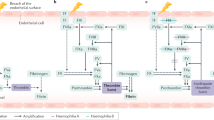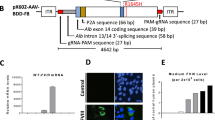Abstract
Haemophilia A is a classic X-linked disease which affects 1 in 5–10,000 males in all populations1 and is caused by defects in coagulation factor VIII2,3. Roughly 60% of patients have severe disease with factor VIII activity <1% of normal; they have frequent spontaneous bleeding into joints, soft tissues, muscles and internal organs. These patients usually require regular injections of plasma-derived or recombinant human factor VIII. Because this is expensive and can potentially lead to life-threatening complications, other forms of therapy, includinggene therapy, have been proposed2. Natural canine models of factor VIII and factor IX deficiency have been available for many years4–5, and gene therapy attempts on these dogs have met with partial success6–8. However, a small animal model of the disease is desirable for studies of factor VIII function and gene therapy. Using gene targeting, we have made a mouse with severe factorVIII deficiency.
This is a preview of subscription content, access via your institution
Access options
Subscribe to this journal
Receive 12 print issues and online access
$209.00 per year
only $17.42 per issue
Buy this article
- Purchase on Springer Link
- Instant access to full article PDF
Prices may be subject to local taxes which are calculated during checkout
Similar content being viewed by others
References
Rizza, C.R. & Spooner, R.J.D. Treatment of haemophilia and related disorders in Britain and Northern Ireland during 1976–1980: Report on behalf of the Directors of Haemophilia Centres in the United Kingdom. Br. med. J. 286, 391–402 (1983).
Sadler, J.E. & Davie, E.W. Haemophilia A, haemophilia B and von Willebrand's disease. in The Molecular Basis of Blood Disease. (eds Stamatoyanopoulos, G. et al.) 575–630 (W.B. Saunders, Philadelphia, 1987).
Kazazian, H.H. Jr., Tuddenham, E.G.D. & Antonarakis, S.E. Haemophilia A and parahaemophilia: deficiencies of factors VIII and V. in Medical and Metabolic Basis of Inherited Disease, 7th edn (eds Scriver, C. et al.) 3241–3267 (McGraw-Hill, New York, 1995).
Graham, J.B. & Brinkhous, K.M. Canine and equine haemophillia, in Hand book of Haemophilia (eds Graham, J.B. et.al) (Elsevier, New York, 1975).
Evans, J.P. et al. Canine haemophilia B resulting from a point mutation with unusual consequences. Proc. natn. Acad. Sci. U.S.A. 86, 10095–10099 (1989).
St Louis, D. & Verma, I.M. An alternative approach to somatic gene therapy. Proc. natn. Acad. Sci. U.S.A. 85, 3150–3154 (1988).
Kay, M.A. et al. In vivo gene therapy of haemophilia B: Sustained partial correction in factor IX-deficient dogs. Science 262, 117–119 (1993).
Kay, M.A. et al. in vivo hepatic gene therapy: Complete albiet transient correction of factor IX deficiency in haemophilia B dogs. Proc. natn. Acad. Sci. U.S.A. 91, 2353–2357 (1994).
Gitschier, J. et al. Characterization of the human factor VIII gene. Nature 312, 326–330 (1984).
Wood, W.I. et al. Expression of active human factor VIII from recombinant DNA clones. Nature 312, 330–337 (1984).
Vehar, G.A. et al. Structure of human factor VIII. Nature 312, 337–342 (1984).
Toole, J.J. et al. Molecular cloning of a cDNA encoding human antihaemophilic factor. Nature 312, 342–347 (1984).
Wion, K.L. et al. Distribution of factor VIII: mRNA and antigen in human liver and other tissues. Nature 317, 726–728, (1985).
Lakich, D., Kazazian, H.H. Jr, Antonarakis, S.E. & Gitschier, J. Inversions disrupting the factor VIII gene are a common cause of severe haemophilia A. Nature Genet. 5, 236–241 (1993).
Naylor, J.A., Brinke, A., Hassock, S., Green, P.M. & Giannelli, F. Characteristic mRNA abnormality found in half the patients with severe haemophilia A is due to large gene inversions. Hum. molec. Genet. 2, 1773–1778 (1993).
Rossiter, J.P. et al. Factor VIII gene inversions causing severe haemophilia A originate almost exclusively in male germ cells. Hum. molec. Genet. 3, 1035–1039, (1994).
Antonarakis, S.E., Kazazian, H.H. Jr. & Tuddenham, E.G.D. Molecular etiology of factor VIII deficiency in haemophilia A. Hum. Mut. 5, 1–22 (1995).
Hoyer, L.W. & Scandella, D. Factor VIII inhibitors: Structure and function in autoantibody and haemophilia A patients. Sem. hematol. 31, 1–5 (1994).
Aledort, L. Inhibitors in haemophilia patients: Current status and management. Am. j. Hematol. 47, 208–217 (1994).
Sambrook, J., Fritsch, E.F. & Maniatis, T. Molecular cloning, a laboratory manual. 2nd edn (Cold Spring Harbor Laboratory Press, 1989).
Deng, W.P. & Nickoloff, J.A. Site-directed mutagenesis of virtually any plasmid by eliminating a unique site. Anal. Biochem. 200, 81–89 (1992).
Wassarman, P.M. & DePamphilis, M.L. Guide to techniques in mouse development. Meth. Enzymol. 225, 803–879 (1993).
Saiki, R.K. et al. Primer-directed enzymatic amplification of DNA with a thermostable DNA polymerase. Science 239, 487–491 (1988).
Rosen, S. et al. Clinical application of a chromogenic substrate method for determination of factor VIII activity. Thomb. Haem. 54, 818–823 (1985).
Proctor, R.R. & Rapaport, S.I. The partial thromboplastin time with kaolin: Simple screening test for first stage plasma factor deficiencies. Am. J. Clin. Pathol. 36, 212–218 (1961).
Elder, B., Lakich, D. & Gitschier, J. Sequence of the murine factor VIII cDNA. Genomics 16, 374–379 (1993).
Thomas, K.R. & Capecchi, M.R. Site-directed mutagenesis by gene targeting in mouse embryo-derived stem cells. Cell 51, 503–512 (1987).
Soriano, P., Montgomery, C., Geske, R. & Bradley, A. Targeted disruption of the c-src proto-oncogene leads to osteopetrosis in mice. Cell 64, 693–702 (1991).
Author information
Authors and Affiliations
Rights and permissions
About this article
Cite this article
Bi, L., Lawler, A., Antonarakis, S. et al. Targeted disruption of the mouse factor VIII gene produces a model of haemophilia A. Nat Genet 10, 119–121 (1995). https://doi.org/10.1038/ng0595-119
Received:
Accepted:
Issue Date:
DOI: https://doi.org/10.1038/ng0595-119
This article is cited by
-
Vagus nerve stimulation primes platelets and reduces bleeding in hemophilia A male mice
Nature Communications (2023)
-
Deletion of Coagulation Factor IX Compromises Bone Mass and Strength: Murine Model of Hemophilia B (Christmas Disease)
Calcified Tissue International (2021)
-
Hemophilia A and B mice, but not VWF−/−mice, display bone defects in congenital development and remodeling after injury
Scientific Reports (2019)
-
Curing hemophilia A by NHEJ-mediated ectopic F8 insertion in the mouse
Genome Biology (2019)
-
Enhancing the pharmaceutical properties of protein drugs by ancestral sequence reconstruction
Nature Biotechnology (2017)



